2004 SUBARU IMPREZA WRX tire size
[x] Cancel search: tire sizePage 57 of 491
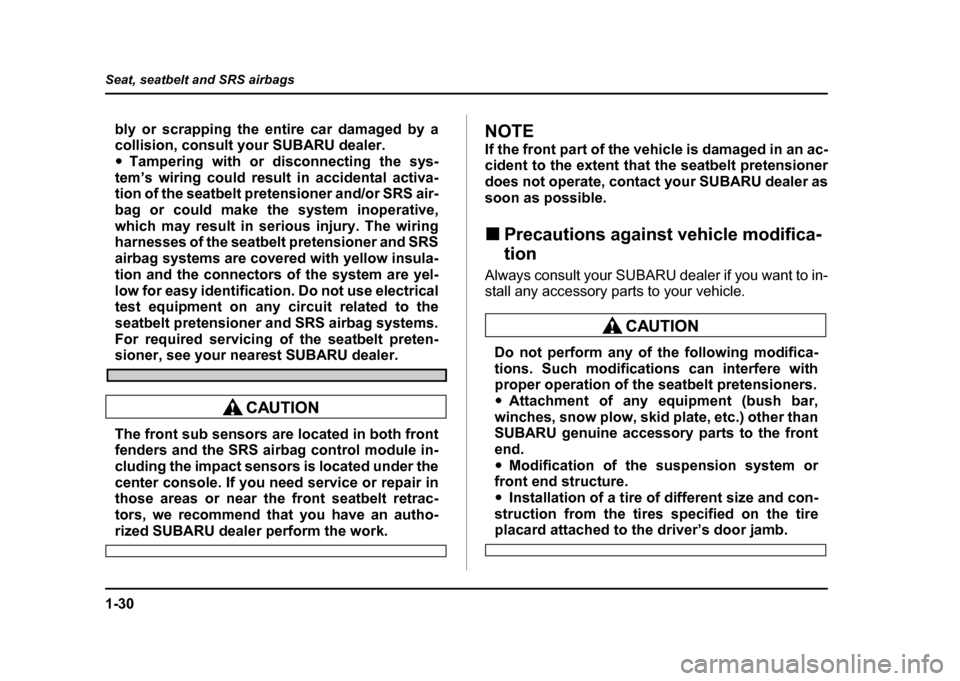
1-30
Seat, seatbelt and SRS airbags
bly or scrapping the entire car damaged by a
collision, consult your SUBARU dealer. "
Tampering with or disconnecting the sys-
tem’s wiring could result in accidental activa-
tion of the seatbelt pretensioner and/or SRS air-
bag or could make the system inoperative,
which may result in serious injury. The wiring
harnesses of the seatbelt pretensioner and SRS
airbag systems are covered with yellow insula-
tion and the connectors of the system are yel-
low for easy identification. Do not use electrical
test equipment on any circuit related to the
seatbelt pretensioner and SRS airbag systems.
For required servicing of the seatbelt preten-
sioner, see your nearest SUBARU dealer.
The front sub sensors are located in both front
fenders and the SRS airbag control module in-
cluding the impact sensors is located under the
center console. If you need service or repair in
those areas or near the front seatbelt retrac-
tors, we recommend that you have an autho-
rized SUBARU dealer perform the work.
NOTE
If the front part of the vehicle is damaged in an ac-
cident to the extent that the seatbelt pretensioner
does not operate, contact your SUBARU dealer as
soon as possible. ! Precautions against vehicle modifica- tion
Always consult your SUBARU dealer if you want to in-
stall any accessory parts to your vehicle.
Do not perform any of the following modifica-
tions. Such modifications can interfere with
proper operation of the seatbelt pretensioners. " Attachment of any equipment (bush bar,
winches, snow plow, skid plate, etc.) other than
SUBARU genuine accessory parts to the front
end." Modification of the suspension system or
front end structure." Installation of a tire of different size and con-
struction from the tires specified on the tire
placard attached to the driver’s door jamb.
Page 102 of 491
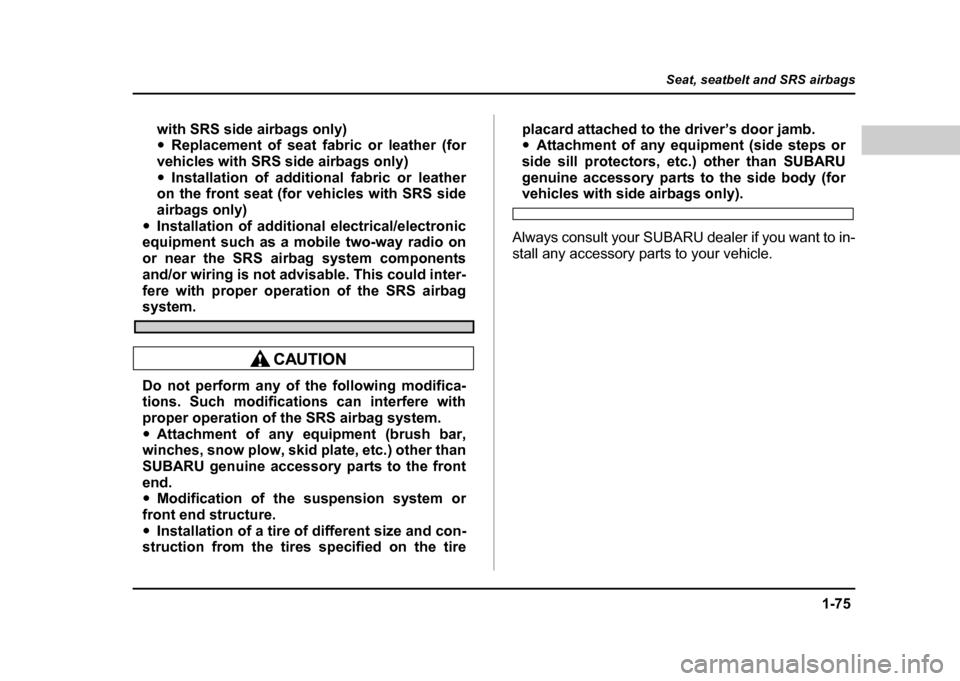
1-75
Seat, seatbelt and SRS airbags
– CONTINUED –
with SRS side airbags only) "Replacement of seat fabric or leather (for
vehicles with SRS side airbags only) " Installation of additional fabric or leather
on the front seat (for vehicles with SRS side
airbags only)
" Installation of additional electrical/electronic
equipment such as a mobile two-way radio on
or near the SRS airbag system components
and/or wiring is not advisable. This could inter-
fere with proper operation of the SRS airbag
system.
Do not perform any of the following modifica-
tions. Such modifications can interfere with
proper operation of the SRS airbag system." Attachment of any equipment (brush bar,
winches, snow plow, skid plate, etc.) other than
SUBARU genuine accessory parts to the front
end. " Modification of the suspension system or
front end structure. " Installation of a tire of different size and con-
struction from the tires specified on the tire placard attached to the driver’s door jamb. "
Attachment of any equipment (side steps or
side sill protectors, etc.) other than SUBARU
genuine accessory parts to the side body (for
vehicles with side airbags only).
Always consult your SUBARU dealer if you want to in-
stall any accessory parts to your vehicle.
Page 160 of 491
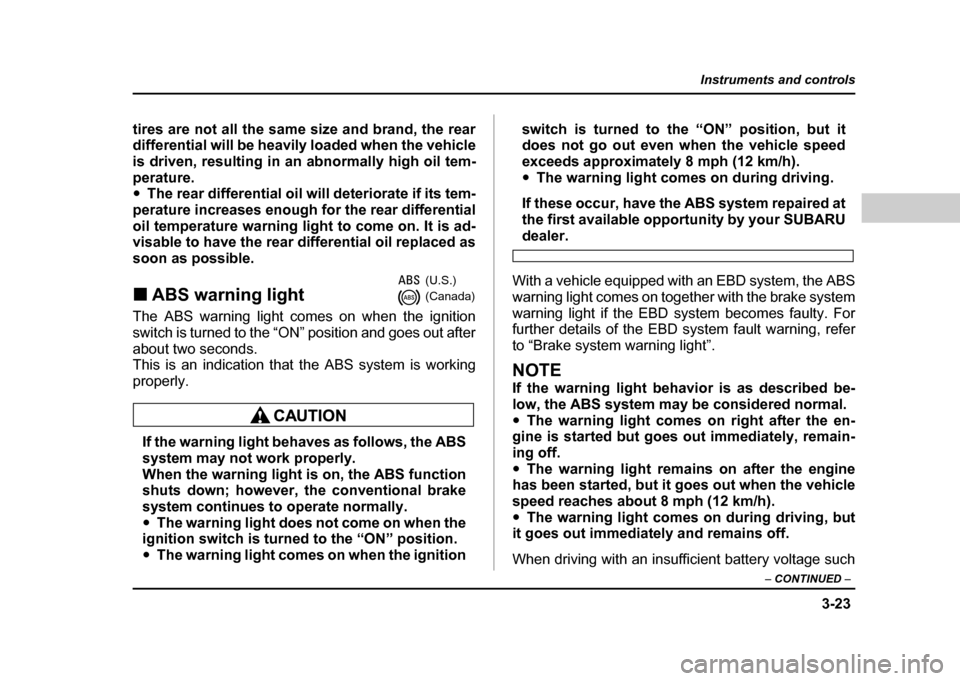
3-23
Instruments and controls
– CONTINUED –
tires are not all the same size and brand, the rear
differential will be heavily loaded when the vehicle
is driven, resulting in an abnormally high oil tem-
perature. "The rear differential oil will deteriorate if its tem-
perature increases enough for the rear differential
oil temperature warning light to come on. It is ad-
visable to have the rear differential oil replaced as
soon as possible. ! ABS warning light
The ABS warning light comes on when the ignition
switch is turned to the “ON” position and goes out after
about two seconds.
This is an indication that the ABS system is working
properly.
If the warning light behaves as follows, the ABS
system may not work properly.
When the warning light is on, the ABS function
shuts down; however, the conventional brake
system continues to operate normally." The warning light does not come on when the
ignition switch is turned to the “ON” position." The warning light comes on when the ignition switch is turned to the “ON” position, but it
does not go out even when the vehicle speed
exceeds approximately 8 mph (12 km/h)."
The warning light comes on during driving.
If these occur, have the ABS system repaired at
the first available opportunity by your SUBARU
dealer.
With a vehicle equipped with an EBD system, the ABS
warning light comes on together with the brake system
warning light if the EBD system becomes faulty. For
further details of the EBD system fault warning, refer to “Brake system warning light”.
NOTE
If the warning light behavior is as described be-
low, the ABS system may be considered normal." The warning light comes on right after the en-
gine is started but goes out immediately, remain-
ing off." The warning light remains on after the engine
has been started, but it goes out when the vehicle
speed reaches about 8 mph (12 km/h)." The warning light comes on during driving, but
it goes out immediately and remains off.
When driving with an insufficient battery voltage such
(U.S.) (Canada)
Page 318 of 491
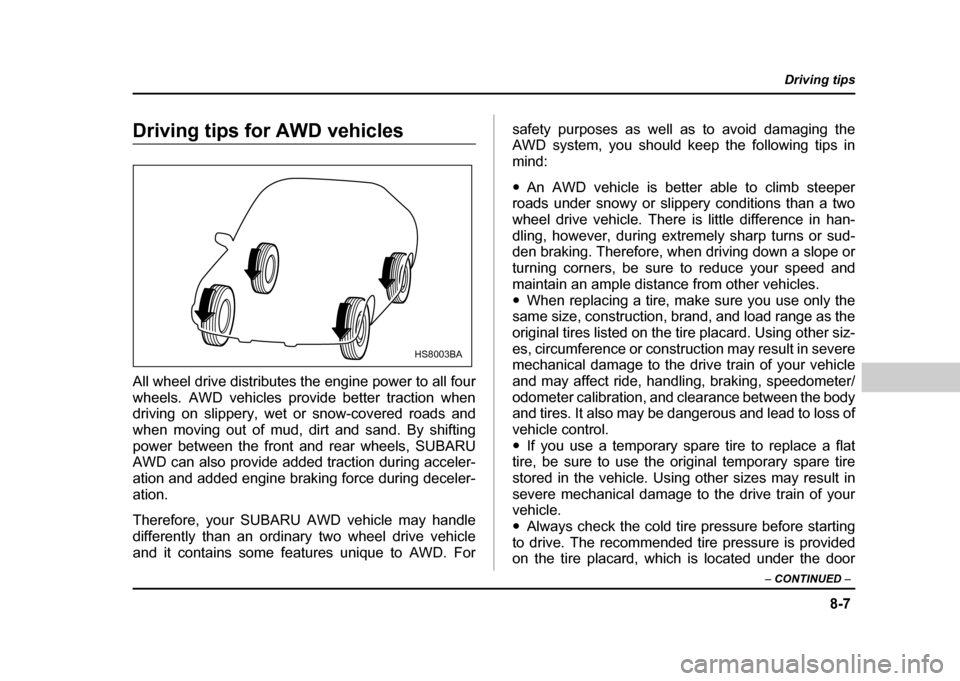
8-7
Driving tips
– CONTINUED –
Driving tips for AWD vehicles
All wheel drive distributes the engine power to all four
wheels. AWD vehicles provide better traction when
driving on slippery, wet or snow-covered roads and
when moving out of mud, dirt and sand. By shifting
power between the front and rear wheels, SUBARU
AWD can also provide added traction during acceler-
ation and added engine braking force during deceler-
ation.
Therefore, your SUBARU AWD vehicle may handle
differently than an ordinary two wheel drive vehicle
and it contains some features unique to AWD. For safety purposes as well as to avoid damaging the
AWD system, you should keep the following tips in mind: "
An AWD vehicle is better able to climb steeper
roads under snowy or slippery conditions than a two
wheel drive vehicle. There is little difference in han-
dling, however, during extremely sharp turns or sud-
den braking. Therefore, when driving down a slope or
turning corners, be sure to reduce your speed and
maintain an ample distance from other vehicles." When replacing a tire, make sure you use only the
same size, construction, brand, and load range as the
original tires listed on the tire placard. Using other siz-
es, circumference or construction may result in severe
mechanical damage to the drive train of your vehicle
and may affect ride, handling, braking, speedometer/
odometer calibration, and clearance between the body
and tires. It also may be dangerous and lead to loss of
vehicle control." If you use a temporary spare tire to replace a flat
tire, be sure to use the original temporary spare tire
stored in the vehicle. Using other sizes may result in
severe mechanical damage to the drive train of your
vehicle. " Always check the cold tire pressure before starting
to drive. The recommended tire pressure is provided
on the tire placard, which is located under the door
HS8003BA
Page 325 of 491

8-14
Driving tips
!
Wiper operation when snowing
Before driving in cold weather, make sure the wiper
blades are not frozen to the windshield or rear window.
If the wiper blades are frozen to the windshield or rear
window, use the defroster with the airflow control dial
in the “ ” position and the temperature control dial
set for maximum warmth until the wiper blades are
completely thawed out. If your vehicle is equipped with
a wiper deicer, it is helpful to thaw the windshield wiper
blades. To thaw out the rear wiper blade, use the rear
window defogger.
When driving in snow, if frozen snow starts to stick on
the surface of the windshield despite wiper operation,
use the defroster with the airflow control dial in “ ”
and the temperature control dial set for maximum
warmth. After the windshield gets warmed enough to
melt the frozen snow on it, wash it away using the
windshield washer.
Snow stuck on the wiper arm prevents the wiper from
working effectively. If snow is stuck on the wiper arm,
pull off the road to a safe place, then remove it. If you
stop the car at road side, use the hazard warning
flasher to alert other drivers.
We recommend use of non-freezing type wiper blades
(winter blades) during the seasons you could have snow and sub-zero temperatures. Blades of this type
give superior wiping performance in snowy conditions.
Be sure to use blades that are suitable for your vehi-cle. !
Corrosion protection
Refer to the “Corrosion protection” section (chapter
10). ! Snow tires
! All models except WRX-STi
"When replacing original tires with winter
(snow) tires, make sure you use only the same
size, construction and load range as the origi-
nal tires listed on the tire placard. Using other
sizes and construction may affect speedome-
ter/odometer calibration and clearance be-
tween the body and tires. It also may be danger-
ous and lead to loss of vehicle control. " You must install four winter tires that are of
the same size, construction, brand, and load
range. Mixing other sizes or constructions may
result in severe mechanical damage to the drive
Page 326 of 491
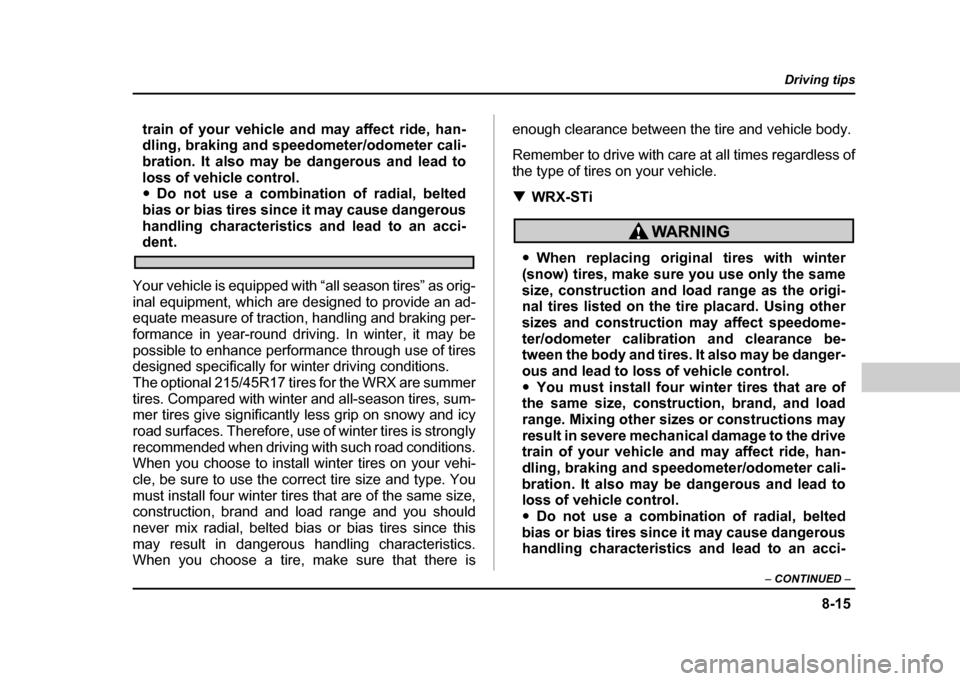
8-15
Driving tips
– CONTINUED –
train of your vehicle and may affect ride, han-
dling, braking and speedometer/odometer cali-
bration. It also may be dangerous and lead to
loss of vehicle control. "Do not use a combination of radial, belted
bias or bias tires since it may cause dangerous
handling characteristics and lead to an acci-
dent.
Your vehicle is equipped with “all season tires” as orig-
inal equipment, which are designed to provide an ad-
equate measure of traction, handling and braking per-
formance in year-round driving. In winter, it may be
possible to enhance performance through use of tires
designed specifically for winter driving conditions.
The optional 215/45R17 tires for the WRX are summer
tires. Compared with winter and all-season tires, sum-
mer tires give significantly less grip on snowy and icy
road surfaces. Therefore, use of winter tires is strongly
recommended when driving with such road conditions.
When you choose to install winter tires on your vehi-
cle, be sure to use the correct tire size and type. You
must install four winter tires that are of the same size,
construction, brand and load range and you should
never mix radial, belted bias or bias tires since this
may result in dangerous handling characteristics.
When you choose a tire, make sure that there is enough clearance between the tire and vehicle body.
Remember to drive with care at all times regardless of
the type of tires on your vehicle. !
WRX-STi"When replacing original tires with winter
(snow) tires, make sure you use only the same
size, construction and load range as the origi-
nal tires listed on the tire placard. Using other
sizes and construction may affect speedome-
ter/odometer calibration and clearance be-
tween the body and tires. It also may be danger-
ous and lead to loss of vehicle control." You must install four winter tires that are of
the same size, construction, brand, and load
range. Mixing other sizes or constructions may
result in severe mechanical damage to the drive
train of your vehicle and may affect ride, han-
dling, braking and speedometer/odometer cali-
bration. It also may be dangerous and lead to
loss of vehicle control. " Do not use a combination of radial, belted
bias or bias tires since it may cause dangerous
handling characteristics and lead to an acci-
Page 327 of 491
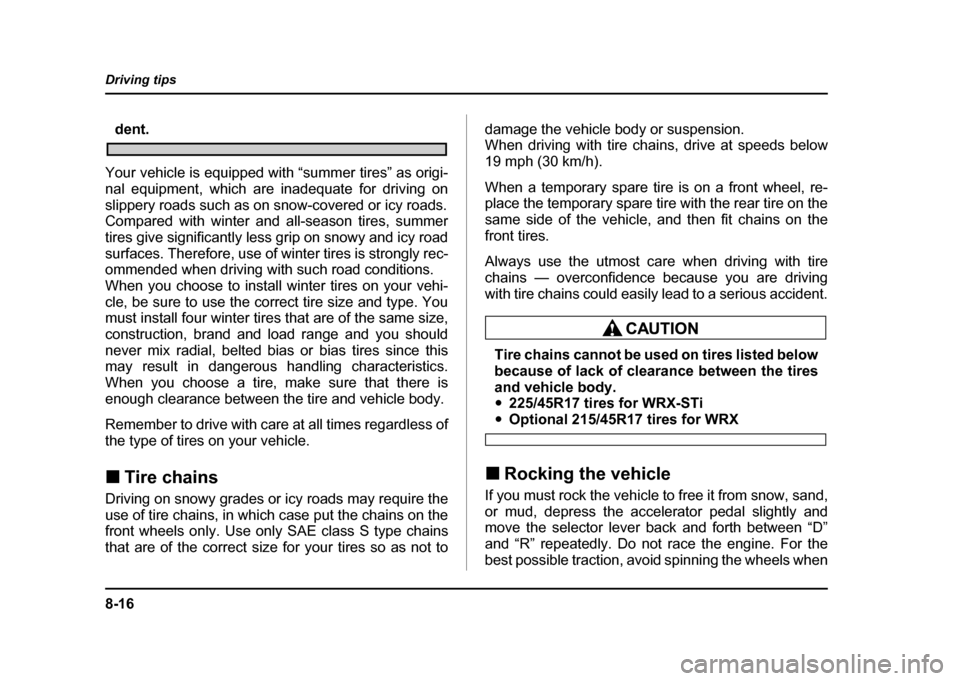
8-16
Driving tips
dent.
Your vehicle is equipped with “summer tires” as origi-
nal equipment, which are inadequate for driving on
slippery roads such as on snow-covered or icy roads.
Compared with winter and all-season tires, summer
tires give significantly less grip on snowy and icy road
surfaces. Therefore, use of winter tires is strongly rec-
ommended when driving with such road conditions.
When you choose to install winter tires on your vehi-
cle, be sure to use the correct tire size and type. You
must install four winter tires that are of the same size,
construction, brand and load range and you should
never mix radial, belted bias or bias tires since this
may result in dangerous handling characteristics.
When you choose a tire, make sure that there is
enough clearance between the tire and vehicle body.
Remember to drive with care at all times regardless of
the type of tires on your vehicle. ! Tire chains
Driving on snowy grades or icy roads may require the
use of tire chains, in which case put the chains on the
front wheels only. Use only SAE class S type chains
that are of the correct size for your tires so as not to damage the vehicle body or suspension.
When driving with tire chains, drive at speeds below
19 mph (30 km/h).
When a temporary spare tire is on a front wheel, re-
place the temporary spare tire with the rear tire on the
same side of the vehicle, and then fit chains on the
front tires.
Always use the utmost care when driving with tire
chains — overconfidence because you are driving
with tire chains could easily lead to a serious accident.
Tire chains cannot be used on tires listed below
because of lack of clearance between the tires
and vehicle body. "
225/45R17 tires for WRX-STi
"Optional 215/45R17 tires for WRX
! Rocking the vehicle
If you must rock the vehicle to free it from snow, sand,
or mud, depress the accelerator pedal slightly and
move the selector lever back and forth between “D”
and “R” repeatedly. Do not race the engine. For the
best possible traction, avoid spinning the wheels when
Page 340 of 491
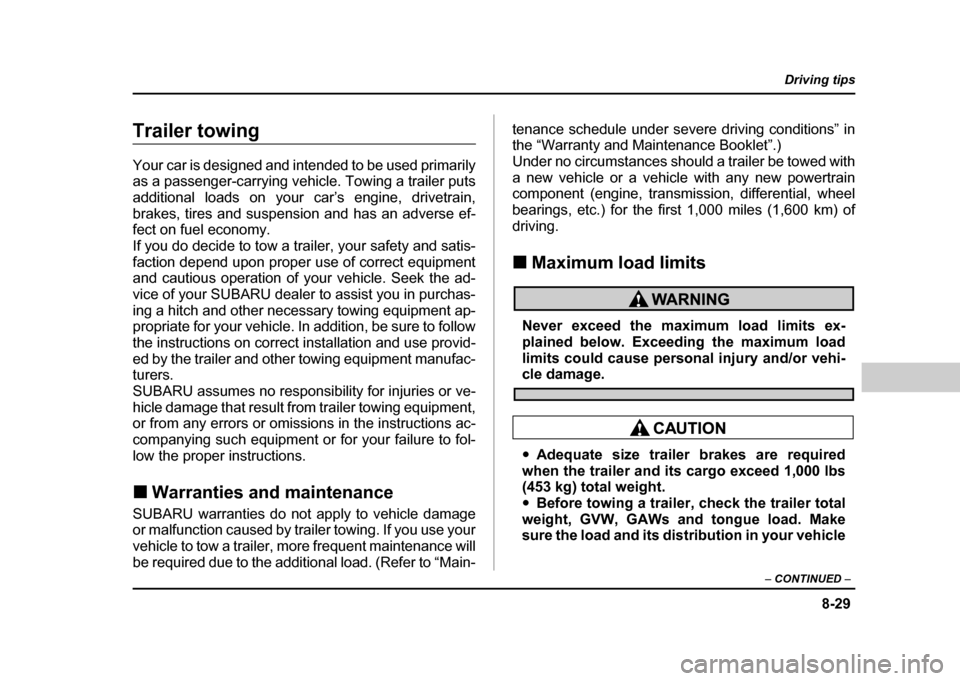
8-29
Driving tips
– CONTINUED –
Trailer towing
Your car is designed and intended to be used primarily
as a passenger-carrying vehicle. Towing a trailer puts
additional loads on your car’s engine, drivetrain,
brakes, tires and suspension and has an adverse ef-
fect on fuel economy.
If you do decide to tow a trailer, your safety and satis-
faction depend upon proper use of correct equipment
and cautious operation of your vehicle. Seek the ad-
vice of your SUBARU dealer to assist you in purchas-
ing a hitch and other necessary towing equipment ap-
propriate for your vehicle. In addition, be sure to follow
the instructions on correct installation and use provid-
ed by the trailer and other towing equipment manufac-
turers.
SUBARU assumes no responsibility for injuries or ve-
hicle damage that result from trailer towing equipment,
or from any errors or omissions in the instructions ac-
companying such equipment or for your failure to fol-
low the proper instructions. !Warranties and maintenance
SUBARU warranties do not apply to vehicle damage
or malfunction caused by trailer towing. If you use your
vehicle to tow a trailer, more frequent maintenance will
be required due to the additional load. (Refer to “Main- tenance schedule under severe driving conditions” in
the “Warranty and Maintenance Booklet”.)
Under no circumstances should a trailer be towed with
a new vehicle or a vehicle with any new powertrain
component (engine, transmission, differential, wheel
bearings, etc.) for the first 1,000 miles (1,600 km) of
driving. !
Maximum load limits
Never exceed the maximum load limits ex-
plained below. Exceeding the maximum load
limits could cause personal injury and/or vehi-
cle damage.
"Adequate size trailer brakes are required
when the trailer and its cargo exceed 1,000 lbs
(453 kg) total weight." Before towing a trailer, check the trailer total
weight, GVW, GAWs and tongue load. Make
sure the load and its distribution in your vehicle